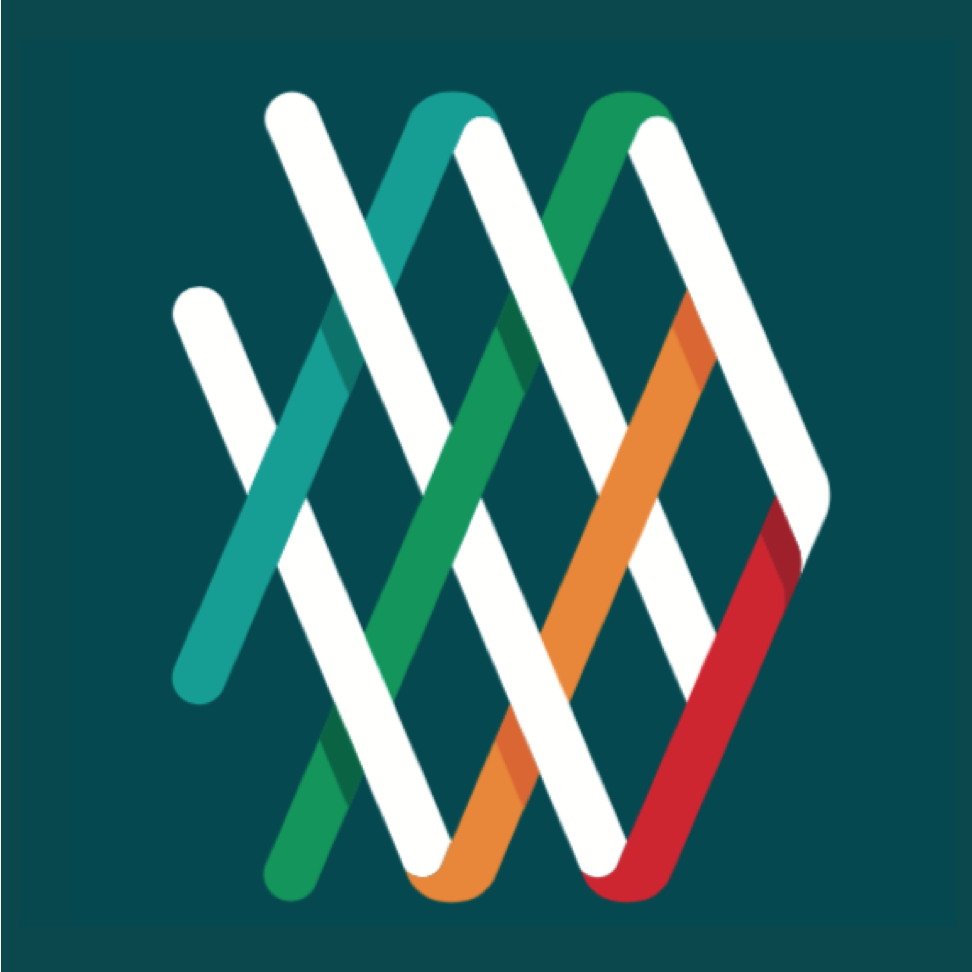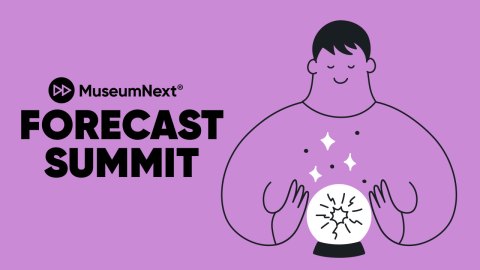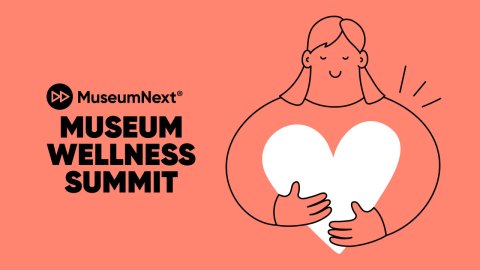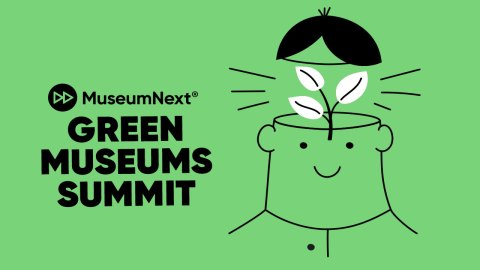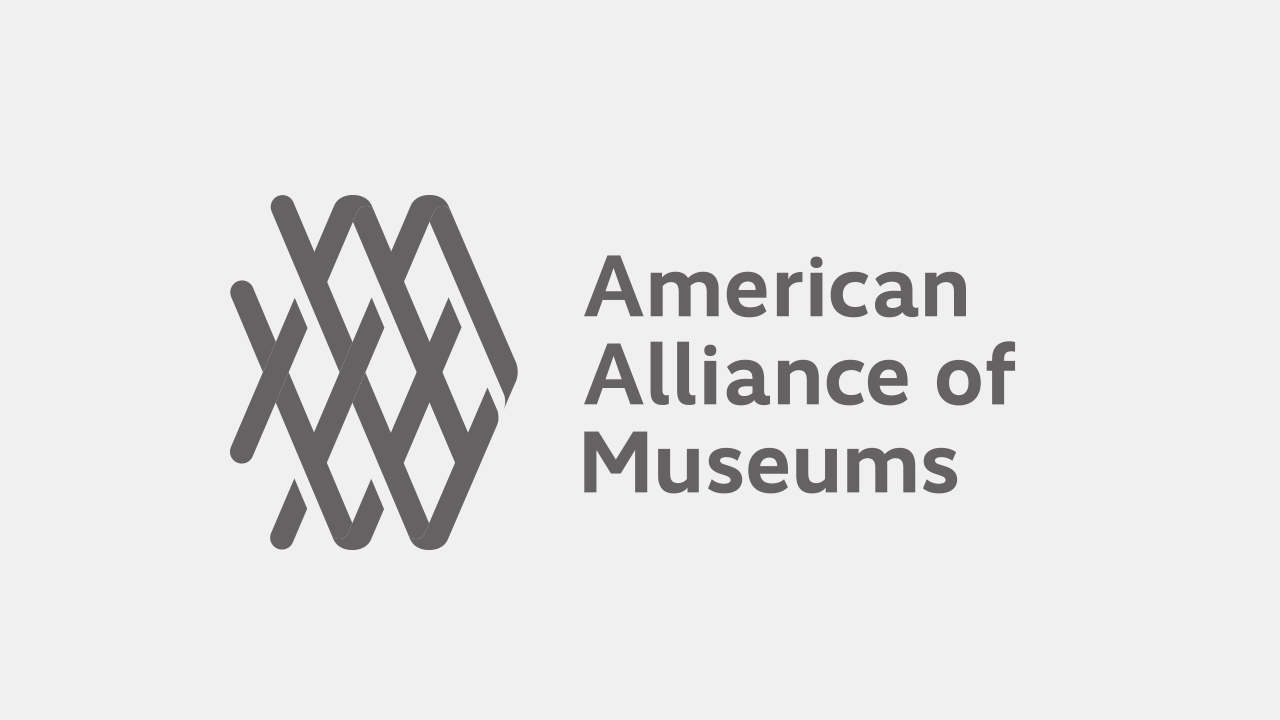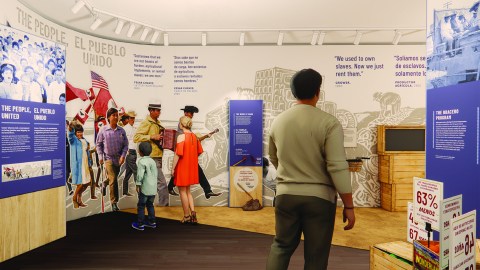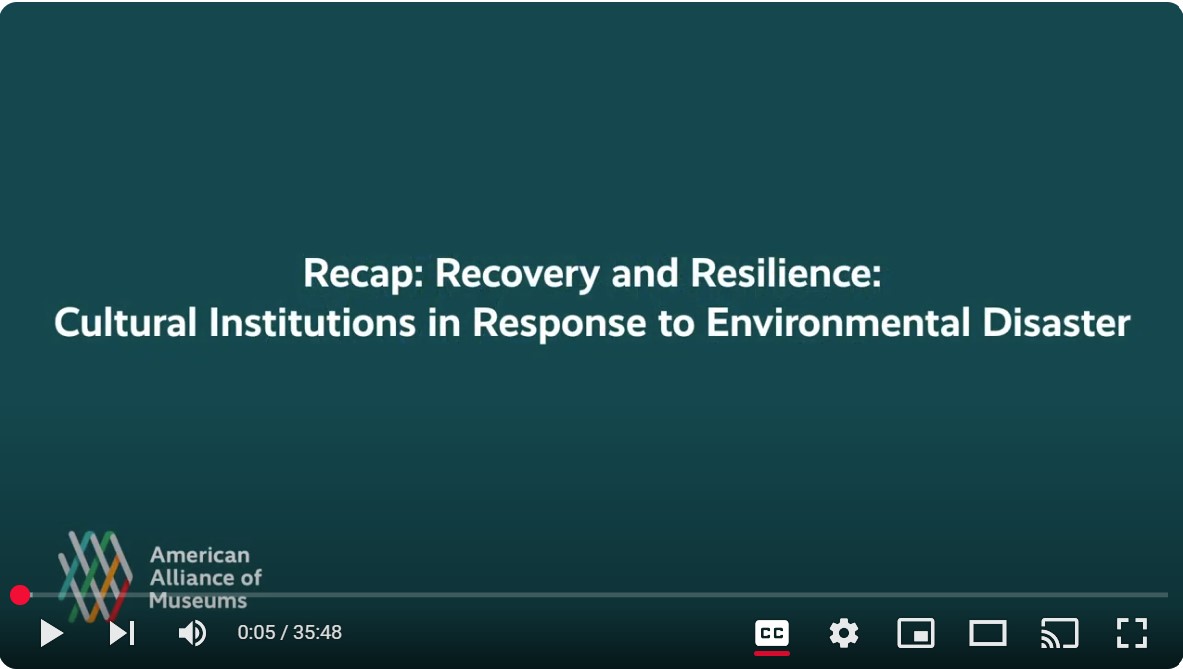
This is a recorded session from the 2025 AAM Annual Meeting & MuseumExpo. From wildfires and hurricanes to floods, recent environmental disasters have tested our communities and cultural institutions—both as vulnerable entities and as essential sources of resilience. As we rebuild, cultural institutions have a unique role in shaping a more resilient future. This convening brought together experts from diverse sectors to explore how these institutions can strengthen communities, share knowledge, and collaborate across disciplines, geographies, and time scales to confront ongoing environmental challenges. Together, they examined how cultural institutions can harness their power to support recovery, renewal, and long-term resilience. In this recap session Camille Kirk takes you through the discussion.
Hosted by AAM in collaboration with Getty and other cultural institutions, philanthropic organizations, and consulting groups from Los Angeles and beyond.
Speakers:
- Camille Kirk, Head of Sustainability, The J. Paul Getty Trust
- Whitney McGuire, Founder, The McGuire Consulting Group
Transcript
Camille Kirk:
Okay, I’m Camille Kirk. I’m head of Sustainability for the J. Paul Getty Trust.
Whitney McGuire:
And I’m Whitney McGuire. I am the founder and managing partner of the McGuire Consulting Group and the former head of sustainability at the Guggenheim Museum. I launched my consultancy last year, and through the networks that we will discuss later, Camille and I were able to connect, and we were able to produce this wonderful convening. Yeah.
Camille Kirk:
All right. How many of you were actually in attendance at the four-hour plus one-hour reception plus extra time talking afterwards convening yesterday? Okay. We have a couple of people who are in for at least part of it. All right. So, for many of you though, this is truly a recap. We’re going to do our best. It’s nearly impossible to synthesize four hours of jam-packed content into… Well, it’ll have to be half an hour, and that is all on me. I misunderstood the time that my other panel for MSA was booked. I had it down as 1:30. Turns out it’s 4:30.
So, we are going to do this in half an hour. But Whitney has graciously agreed to stay and answer any questions. This convening could not have come together without Whitney’s help. She’s been an absolutely instrumental and treasured partner with me in organizing in four weeks, what I think usually would take about four months to organize. It’s been frenetic. With that, we’re going to get started. We’re going to do this as Q&A of Whitney and Camille.
Whitney McGuire:
So, Camille, can you let us know how did this convening come to fruition?
Camille Kirk:
Absolutely, my pleasure. So, many of you I’m sure are intimately familiar at this point with the fires that happened in January in Los Angeles, as well as plenty of other disasters that have befallen us since 20 years ago with Hurricane Katrina in August of 2005. It’s hard to believe it’s been 20 years, right? And yet we’ve had so many disasters since. This convening was really born out of a lot of thought, a lot of anguish, and a lot of conversations with colleagues both across Los Angeles and then well beyond Los Angeles, nationally and internationally.
Once we were sure that we could have a convening here in Los Angeles, we asked AAM if they would be willing to consider a late proposition for a convening on the front end of AAM. They were very gracious and said yes, and then began the really, really fast-paced work to pull together a wide variety of content. This was all informed around several buckets of work. So, what are we doing operationally to prepare our organizations for disaster? What are we doing to do trust building and communications? And this is very broad and has many different tentacles to it. So, it’s very much an octopus of communications. There’s the external communications, media relations. There’s figuring out how to communicate internally.
There’s working with your lenders when you have a show up on the walls and your buildings have fire near them and people are concerned rightfully. Then all this communication work is really built in trust. So, you have to do that trust building and we’re going to talk a little bit about that. Then finally we had a panel on philanthropy, mutual aid, and every support model in between. That’s because when you’re in a disaster, well, when you’re leading up to a disaster, then when you’re in a disaster, then when you’re in the immediate aftermath and the long recovery, you need different forms of support in order to get through.
So, we asked ourselves some questions about that and we ended with some reflections. So, we’ve put up here all of the speakers. You can see that we attempted very much to have it across time, scale all the way back to Katrina. We know that disasters happened before 2005, but we figured two decades was about as much time as we could legitimately get up on stage. Then we also asked our questions across geographies. So, we did not want this to be only the Los Angeles fires. We understand that there are a lot of lessons to learn from each other from all around the country. So, with that, Whitney, what moment or message felt most emotionally resonant or urgent for you yesterday and why?
Whitney McGuire:
So, I think the importance of socializing disaster readiness planning early and often was something that really struck a chord with me. It reminded me of the importance of this concept that environmental and culture partners raise, which is this idea of friends from before. I love that phrasing because it’s just a different way to consider one’s network. These are the people that you are going to immediately activate in the wake of disaster before you reach out to city agencies, before you reach out to institutions, before you even find mutual aid support that is beyond just your immediate network of support. So, this idea of friends from before is something that resonated with me.
When you think about that in the institutional context, what type of networks have institutions built in preparation for disaster and who are those friends from before that you can really connect with in the wake of disaster? So that you are more prepared to communicate, to communicate with trust, to build trust, and to support those affected by disasters, which as Camille said, are becoming more and more imminent for all of us here. So, that idea of socializing these networks of influence in ways that are… It seems to be second nature, but for me, I didn’t put two and two together before this event.
Raising your disaster readiness plan frameworks in staff meetings or bringing them up in fun ways like gamifying them to really just inspire people to feel like that they’re a part of this disaster readiness planning, that they have a role to play and the importance of their ability to activate their own networks in the wake of disaster as well, to identify their own friends from before. So, that’s one thing that resonated.
Camille Kirk:
That’s great. I think in lighting on friends from before, which was a really delicious way to reframe networking, which always sounds so dreadful, right? You’re going to have to schmooze and shake a lot of hands and come up with small talk. No, this is really about resilience only happens in community. So, you’re resilient with others. You’re never resilient alone. You can certainly have a disaster preparedness plan that is very self-oriented as an institution and has self-reliance built into it. Frankly, there should be an element of that for sure, but you are resilient, and your resilience plan is with others. It’s with your friends from before. It’s with the network that you’re building. It’s with those first responders. The goal is to build your community.
Whitney McGuire:
Just want to say that we have environment and cultural partners in the rooms with us today. So, if you have any questions about this concept of friends from before, please connect with Sarah and Stephanie.
Camille Kirk:
You said something else that I think is really important, which came up with Mollie Quinlan-Hayes from NCAPER. So, she led us through a short exercise in asking yourself, “What do you need? Who do you need to be consulting with and what do you need to be thinking about to create a disaster preparedness plan?” And she had two, I think, genius pro tips. One was, no, don’t feel any guilt. Just because you haven’t already got the perfect plan or any plan, no guilt, no guilt, get started now. No guilt. She sounded like my yoga teacher. It was fabulous. I felt very like-
Whitney McGuire:
You can do it.
Camille Kirk:
You can do this. Then the other thing which Whitney touched on was this idea of chew the elephant one bite at a time. Don’t try to like, okay, we’re going to have a five-day workshop and all hands-on deck, and everyone has to clear those. That’s never going to happen. We all have one and a half full-time jobs already. This is coming on top of it. As Whitney alluded to, there were these ideas of slip it in into already existing structure that you have, already existing meetings, already existing retreats, already existing efforts. Don’t make it a huge burden and then it won’t get done. So, I thought that was a really fantastic pro tip. So, what did you observe, speaking of that planning exercise about how participants responded to the planning exercise or panel discussions? Did you feel any shift in the energy in the room?
Whitney McGuire:
Yeah, so we started with three lightning talks. Actually, we had a keynote and then we had three lightning talks. So, I think actually two. How many did we have? Yes, sorry. It was yesterday and I feel like my brain is like, “Please rest.” So, the point is that the talks before the disaster readiness planning activity, the workshop that we did really set the stage for the workshop. I think that people were really interested in the stories that were told in these talks. We had Erik Ghenoiu.
Camille Kirk:
Ghenoiu?
Whitney McGuire:
Sorry, Erik, if you’re in the room. We had Ade Ayoade from SCI-Arc as well deliver a keynote. One thing that really resonated for me was the importance of narrative and storytelling in the process of supporting, rebuilding, and recovery in the wake of the wildfires. So, that was one aspect that I think people were really eager to highlight in their disaster readiness planning frameworks. We also learned from Joseph Cuillier from The Black School about the presence of actually slow disaster, which is something that we don’t really consider often when we’re thinking about emergency readiness.
But slow disasters are if you want to build a community garden, but you have to spend months or years clearing topsoil because you are located in a part of the world that has been impacted by environmental injustice and therefore there are high levels of lead concentration in the topsoil, or you are addressing or impacting a community that has been impacted by mass incarceration at rates that are disproportionate than other communities. These types of slow disasters are also something that need to come to mind when we’re thinking about network building as well as disaster readiness planning. So, I think those nuances were really interesting and allowed people to think more deeply and critically about the ways that they were planning or framing their disaster readiness plans.
Camille Kirk:
That’s great. I agree completely. I would say that’s also one of the underpinnings of why this convening got organized. I mean, here in LA, we have about six different commissions and recovery groups and then 30 more ad hoc ones. This is very typical after a disaster. Lots of people rush in to figure out what to do next. But so often cultural institutions are left out of the questions around, “What should a rebuild look like and what do we need? Where do we need to go with the future?” This idea of narrative and stories is exactly the thing we are so good at.
Artists interpret the human condition, and if there’s anything that’s a human condition is facing disaster. We all can go back to seventh grade English class, man against nature. What are we going to do to bring our very most unique strengths and roles in society to help our communities understand where to go next as they recover from disaster, be it slow disaster or a rapidly unfolding disaster like fires or floods? So, I really appreciated that framing on narrative. It was a very important one and it really goes right back to the heart of what a cultural institution brings to the table. Should we shift to some of the-
Whitney McGuire:
Talk about money.
Camille Kirk:
Okay, let’s talk about money. Money, always money.
Whitney McGuire:
Right? Well, this question is for both of us, but what gaps or tensions became clearer for you either around philanthropy, mutual aid, institutional trust, or preparedness?
Camille Kirk:
Well, okay, so there were two things that got raised repeatedly in the room, probably more than two, but one was loneliness. So, this work can feel really lonely. Who else is out there doing it? Is this just me tilting my sword or my lance? Am I Don Quixote always? And the answer is no. There’s lots of Don Quixotes out there. That’s part of what we wanted to do with this convening.
What we really want to come out of the convening is the prompting of many more conversations and much of that friends from before network building that will really help alleviate some of that loneliness and also help relieve the burden of feeling that you’re not quite sure where to start. You’re not sure if what you’re doing is the right thing or good enough. So, I think that was one.
Whitney McGuire:
Then for me, Julia Hendrickson from Grief and Hope and also co-founder of VERGE, she raised this really salient point about the fact that arts workers need to also be included in disaster readiness and recovery. Oftentimes we’re thinking about the artifacts or the building or the artists themselves, how people were impacted. There are mutual aid campaigns for artists and for institutions, but for arts workers, I think that that’s something that’s a gap that could be filled and should be filled in the future. That’s something that I think was a learning for many folks who were engaged in mutual aid in the wake of the wildfires.
Camille Kirk:
Yeah, excellent. I agree completely. That was one of the things that I was really proud of with the Fire Relief Fund, is that it was accessible not only by artists, but also by arts workers. That is such, as Whitney just made the case for, such an important thing. We cannot have museums and cultural institutions without all of the massive numbers of people that support what it takes to open those doors to the public and tell those stories. So, this question’s also for both of us. Which panel or session offer the most actionable insight for the work that we’re doing on these topics?
Whitney McGuire:
Well, for me, I loved the philanthropy panel, not because I moderated it, and I also enjoyed Joseph’s talk too. I enjoyed the whole convening for those of you who were also speaking, but specifically the emphasis on the importance of intersectionality and inclusion when it comes to what we even consider disaster, which I pulled from Joseph, as well as the importance of supporting arts workers from the very beginning, prior to disaster, I thought was really interesting and something that I can definitely take into the strategic planning work that I do for arts and culture institutions.
Camille Kirk:
I’ll say for me, I found that there was a thread that ran through. Well, first of all, we did really intentionally build this so that each session built upon what came before. We were delighted to have people come up afterwards and said, “So we noticed that there was a progression and that things build…” We’re like, “Yes, we nailed it.” That intention was to demonstrate two things. Cultural institutions are both quite vulnerable to change in disaster, but also very important sources of strength and sources of being community hubs in disaster and before disaster. So, they have this weird bipolar existence in society being so vulnerable at the same time as there’s such an important strong hub. So, what I found about that was…
It goes right back to Katelynn Averyt from Smithsonian actually pointed this out. It’s beautifully tied coincidentally to the theme of this year’s AAM, Museums and Trust. So, one of the things I thought was super actionable and important is that sense of doing the trust building work, which is about putting the time in. It’s about building those friends from before and that network, reaching out, finding ways to stay very connected with each other, which can feel like an extra job, but also can make your work a lot easier and more effective when you have those friends that you can work with and lean on.
Whitney McGuire:
I think community was something that really came up in the reflections that we asked people to provide us at the end of the workshop. So, when we think about community, usually it’s based on family or friends or who you know, but it’s not necessarily rooted in network building. So, I think this idea of friends from before and network building really merged to strengthen this idea of community, which is something that is very important to the work that I do. I cannot do the work that I do without community.
You are a part of my community. Most of the speakers yesterday are part of my community. I think that this loneliness, it’s an epidemic really. This loneliness aspect of the work that we do was highlighted because most people are really just craving connection. Most people want to coalition build. They want to collaborate, especially when it comes to protecting assets, protecting our institutions, protecting each other. So, I was really inspired by people’s sense of urgency in wanting to connect further after the workshop.
Camille Kirk:
I’m going to propose that, so we leave a little bit of audience question time, but because we’ve talked quite a bit about trust building that we actually skip to our future session.
Whitney McGuire:
I would love that. So, I have a question for you.
Camille Kirk:
Okay.
Whitney McGuire:
How can institutions continue moving from reactive to proactive disaster and climate preparedness?
Camille Kirk:
I’m terrified if I say the word network one more time that you might come at me with spears because you’re tired of hearing it. But I will say I think that that was one really important aspect that came out. One of the other things I think that people and institutions can do is take to heart the tools that are provided. AAM has tools. Environment and Cultural Partners has tools. NCAPER has tools. Smithsonian’s Disaster Response Group has tools. There are lots of tools out there to help you go through the preparedness plan work. My pro tip, in addition to the two that came from Mollie at NCAPER about don’t feel guilty, just get started and insert it into other work that you’re doing. Just take it a chunk at a time.
My pro tip is to find ways to ask yourself, “Who else should I be including?” Sometimes we forget to ask like let’s think across that whole org chart, who else might have an interest, a perspective, and a need that we should ask as we’re preparing to confront and deal with a disaster? So that instinct to draw the circle wider is not one we always have. I encourage you to exercise that inclusive muscle to think about who else you could bring into your circle and help make the work easier.
I often reflect on a mentor in my earlier career who told me about Dwight David Eisenhower’s framing of a problem and said, “If you can’t find a solution to a problem, you haven’t made it big enough yet.” The corollary that goes with that is it’s because you haven’t included enough people in the problem solving. When you draw that circle bigger, there will be more brains coming to the table to help you solve the problem. Well, let’s see. So, Whitney, reviewing the responses that we got from the final workshop exercise, what stands out for you?
Whitney McGuire:
I mean, you’re going to come at me with spears too, because I’m going to repeat this idea of friends from before and community, just the importance of essentially identifying those networks of influence within your institutions and outside of your institutions. I loved this idea of opening your institutions up to first responders prior to a disaster so that they’re even aware of what the lay of the land looks like inside. They know what needs to be preserved and protected. The way first responders respond to a museum is different than the way they respond to a house fire.
You just want to make sure that they’re aware of your institution and also just to build those relationships with the people who you know will be relying on for your safety. So, I think that this idea of community is written throughout. So, I think that that’s something that really resonated with me from those responses.
Camille Kirk:
That is great. I would say that for me, I mean echoing the community thing, for me, one of the things that really stuck out was our final session on philanthropy and different models of support led to… They didn’t know that they were doing this. Thank you. It helps to know what key to push on the computer. I wonder sometimes if humans just accidentally illiterate things when they listen to each other and they don’t even know that they’re doing it. But all these P words came out and I was like, “Oh, it’s the five Ps. This is like the two long, did not read version of a four-hour workshop.” So, Julia from VERGE and Grief and Hope said, “Patience. Have patience.”
Yes, patience with yourself. I mean, that came up with the don’t feel guilty if you don’t already have a great disaster preparedness plan already cooked in the hopper. Pilots, so this came from Kelsey Shell at MOCA-LA. This is a pro tip. I also use this all the time. If you’re hearing no, well, first of all, when you hear no, you should think what I heard was not yet. So, what do I need to know? What are the things that are making this person say no to me? Maybe I can help resolve those. Maybe we can allay those fears and concerns, or maybe we can come up with solutions for what might feel like resource challenges or security challenges or who knows what the issues are.
But often the magic is doing something at a small scale, experimenting, calling it a pilot, trying something out, intentionally learning lessons from it, allowing there to be failure and harvesting lessons from that failure and being completely okay with it. So, I would observe, I came from higher education, which is filled with perfectionists. I came to the museum world, which is filled with perfectionists. All the people who are very smart and always made A’s, and they did all the extra credit, and they’re not about to fail now. So, what I would say is it’s not exactly failure. You’re experimenting. Like any good scientist, you’re trying some things out. Some things go well in confirming the hypothesis and other things, you’re like, “Hmm, going to have to try that a different way.” So, pilots are really helpful.
Whitney McGuire:
You need the data.
Camille Kirk:
You need the data. Yes, we heard that too. That was Julia. It was like, “I’m a data person. Bring me data.” Partnerships and peers, this came from Jim at Frankenthaler Foundation. So, he drew an interesting distinction that I hadn’t really thought of. So, partnerships, you’re looking for people to help you get things done. That can take a lot of different forms. That can look like a lot of different kinds of support and partnering and peers. So, who’s doing stuff like what you’re doing, and you want to learn from each other, and you need a little safe space to talk about things, hair down over a martini talk.
Whitney McGuire:
[inaudible 00:27:12].
Camille Kirk:
Then finally, I think all of them, all of the panelists really given that it was about forms of support, identified that one of the things that we need to do is figure out how to provide for this work. So, I think Whitney, do you want to talk a little bit about the concept of pay up?
Whitney McGuire:
Sure. I mean, we can’t do this work without funding. So, that is a priority. There are ways that especially marrying this idea of pilot and partnerships when raising an idea or an initiative to say leadership, usually as sustainability directors, we know what no’s feel like or not yet. One way to allay those fears that leadership may have when it comes to budget concerns, which are very real, is to know what type of funding strategies are available to you, what type of philanthropic partners may be available to you. I want to, again, shout out Jim from the Frankenthaler Foundation. Raise your hand Jim if you can.
So, they’ve been a really wonderful partner for the past work that I’ve done at the Guggenheim Museum. I know for Kelsey at MOCA-LA, they’ve supported some infrastructure support that we really needed to make sure that our buildings and facilities could withstand potential disasters. So, yeah, we can’t do this without money and also, we can’t do this without adequate pay. So, that’s something that is the elephant in the room, but it is something that really needs to be acknowledged that arts workers, we make the world go round. We also make the institutions run. So, adequate pay is something that’s also necessary.
Camille Kirk:
So that is four hours in 30 minutes, more or less. We have a couple of minutes for questions. Well, I have to then turn into a pumpkin because of my failure to read a calendar correctly. But we would invite anyone who has a question to ask now, and I think-
Whitney McGuire:
there’s a mic here.
Camille Kirk:
… we can stay a little longer. Is this breaking news?
James Merle-Thomas:
Hi guys.
Whitney McGuire:
Hi.
James Merle-Thomas:
Hey, I’m James Merle-Thomas from the Frankenthaler Foundation. Since we spoke yesterday, what I can say is that just today I’m very pleased to share that the Andy Warhol Foundation for the Visual Arts and the Frankenthaler Foundation did a joint announcement. Some of you may be aware of the Challenge America Program. It was canceled by the NEA. So, we stepped in today to fund the federal gap that was left from that. So, those are 272 organizations nationwide. Eighty of those are visual arts organizations. So, basically 80 orgs that were missing $10,000 in federal matching funds, those programs were now jeopardized.
So, we stepped in collaboratively to fill that gap and threw the gauntlet down for people in theater, opera, all of the other things that are not visual arts. But I think it speaks exactly to what you were saying is like it’s not perfect. It’s not complete, but it’s an immediate partnership that addresses a gap. It’s also modeling what we want other funders to be doing in this space. I think the other part of it is that we have now linked those 40. They weren’t necessarily talking to one another before. Now there are 40 plus 40 organizations.
Whitney McGuire:
Friends from before.
James Merle-Thomas:
Friends from before. So, we’re making, yeah, future friends from before.
Whitney McGuire:
Well, done. Thanks, James. Exciting.
Camille Kirk:
Beautiful example.
Whitney McGuire:
It’s a wonderful example. Wow. Hi.
Brian Gable:
Hi, everyone. My name is Brian Gable. I’m the curator of the National Corvette Museum. Eleven years ago, we faced a pretty serious situation that some of you guys may be aware of. We had a sinkhole open underneath one of the galleries in our museum. We had eight cars fall into basically a 30-foot hole into a cave that we didn’t previously know that was there and really, really serious situation. But what we didn’t expect was that the sinkhole drew a lot of publicity and attention, internationally even. We had people come to our museum and discover us who never would’ve even come through the front doors just to see this hole and the damaged cars that were on display for a lot of years.
Of course, we also had an exhibit in the museum about the sinkhole. That exhibit actually closed about six months ago just to make way for something else. Most of the damaged cars aren’t on display anymore. But even so, over a decade removed from the initial incident now, there’s an expectation among our visitors and a lot of our members to see something related to the sinkhole. The hole, of course, has since been filled in.
Whitney McGuire:
You’re a natural history museum now.
Brian Gable:
Right, and that’s the tricky part because it’s not really part of our educational mission. It’s something that’s outside our scope and the new initiatives that we want to do, but it’s a part of our institutional history that we can never totally get away from. So, the question is, I guess, what is the way forward when you have this disaster at your institution that becomes a story in of itself?
Camille Kirk:
Oh, my God. First, I’m giving you my card and we’re going to connect after this because guess what? We’re doing the same thing at our villa where our landscape burned quite a lot. We were very fortunate. Our buildings were safe, our collections were safe, our landscape is toasted. Just going to put it out there, very toasted. Thank you. We are in the middle of trying to figure out how we interpret this for visitors when we open back up. You cannot hide from the devastation. A landscape will grow back. It is already starting to rebound, but trees take a long time. This isn’t going to be an overnight thing. We have to interpret this for visitors. This was not on the game plan.
We did not start January thinking, “Oh, we’re going to add in a fire journey at the villa,” but now we are. So, I think there’s two things that I would take out of this. One, yeah, disasters bring the unexpected. What was that Rahm Emanuel said so many years ago in the Obama administration, never let a good crisis go to waste. So, seize what you can out of it. Use it as an opportunity to connect with your visitors. It’s unfortunate that a disaster makes people want to come and see you, but also, it’s where vulnerability becomes a strength.
When you can share your vulnerability honestly and make it into a strength, into a shared experience, that resonates so strongly with people. They want to understand. That is part of the job of the arts and humanities, is to help people understand how to grapple with our very true vulnerability. We are very vulnerable. We are mortal. It’s terrifying. People want to know how to deal with this. That’s what we’re in the business to help them do. With that, I’m sorry, I’m going to have to say goodbye and go talk about sustainable procurement. Thank you so much.
This recording is generously supported by The Wallace Foundation.
